|
Click on
the pictures to enlarge them
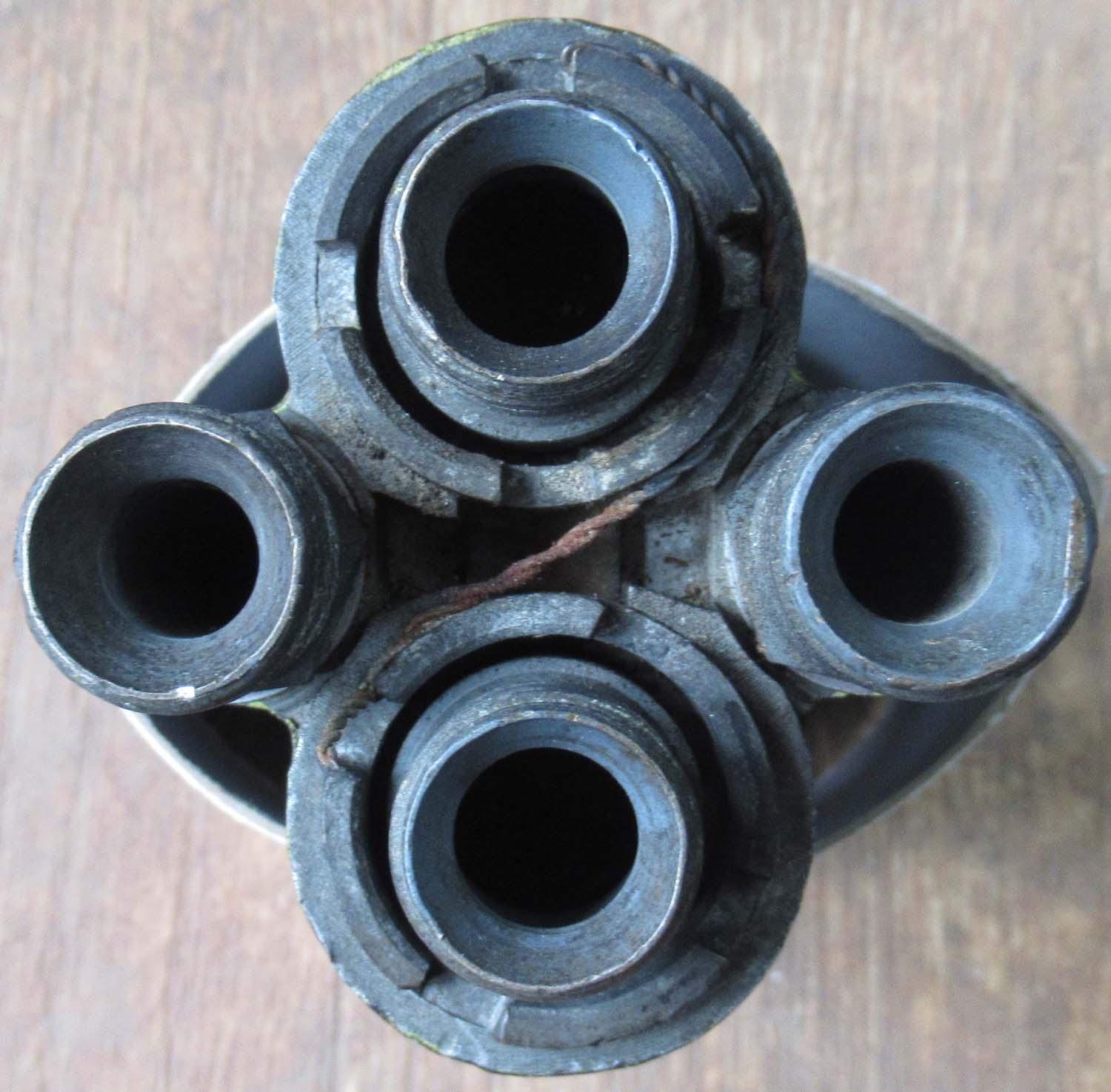
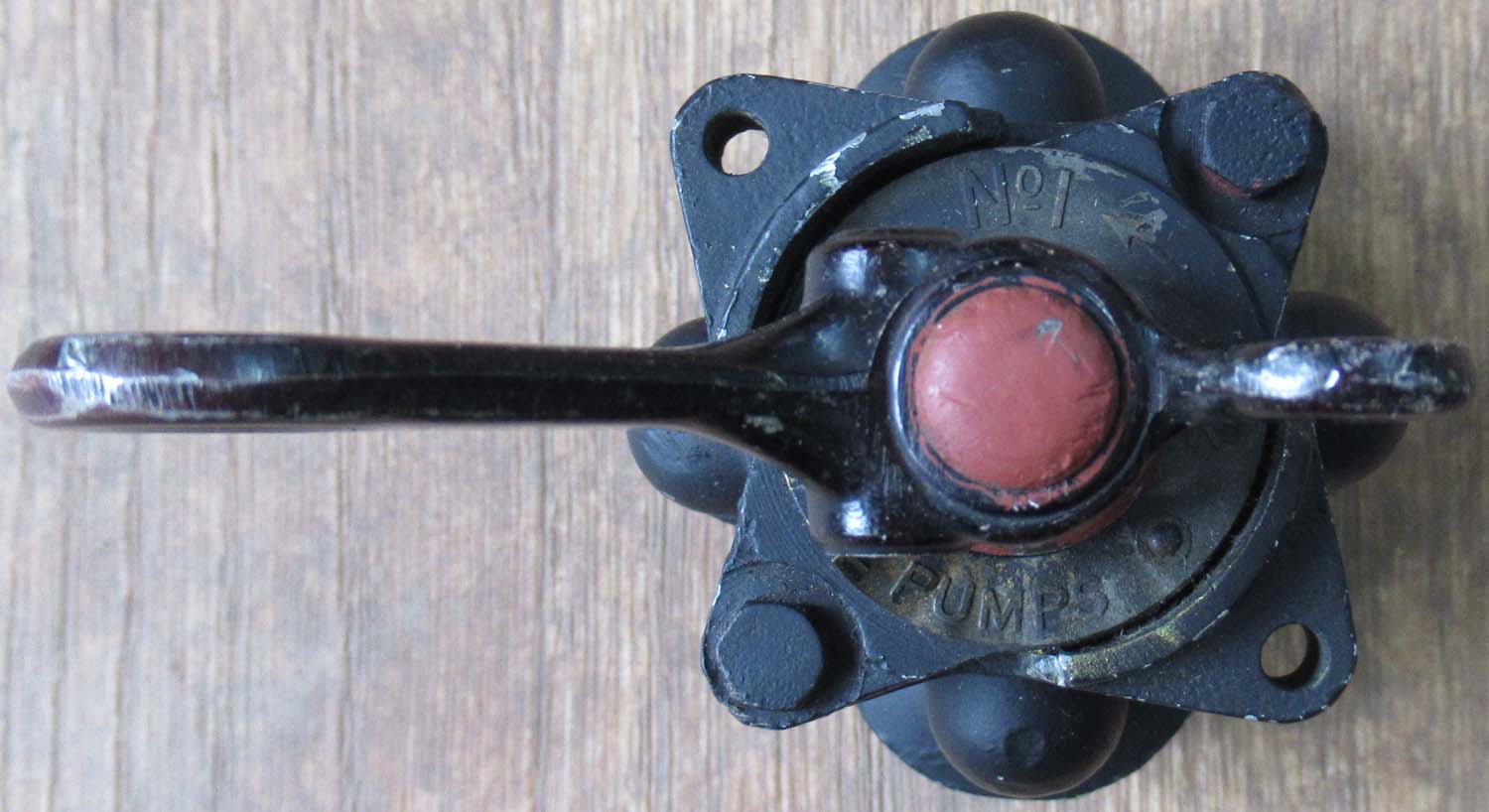

Out of stock more
wanted please
contact me. |
Lancaster
Suction Cock (Cont pg6 No 11) This is
the piece that everyone needs to complete their Lancaster
panel.
A Lancaster suction cock a
totally original piece in good condition and functioning as
it should the only small fault is the instruction label is
slightly bent.
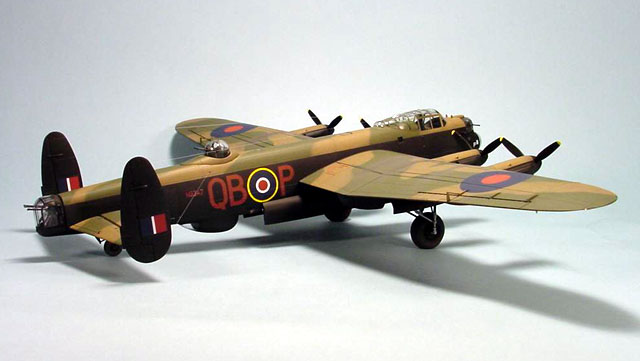
Seen in
situ below in a Lancaster. Click on
the pictures to enlarge them
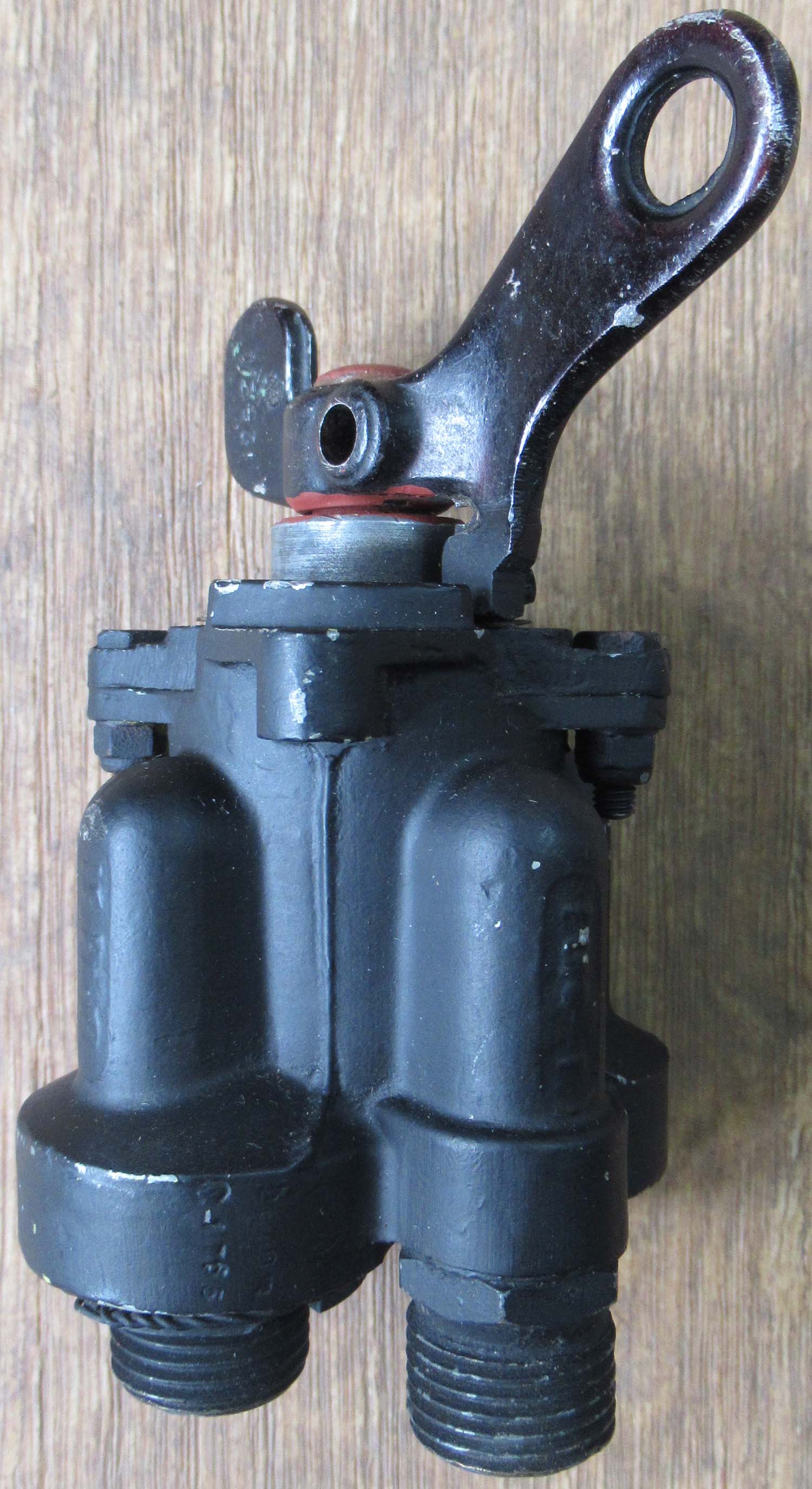

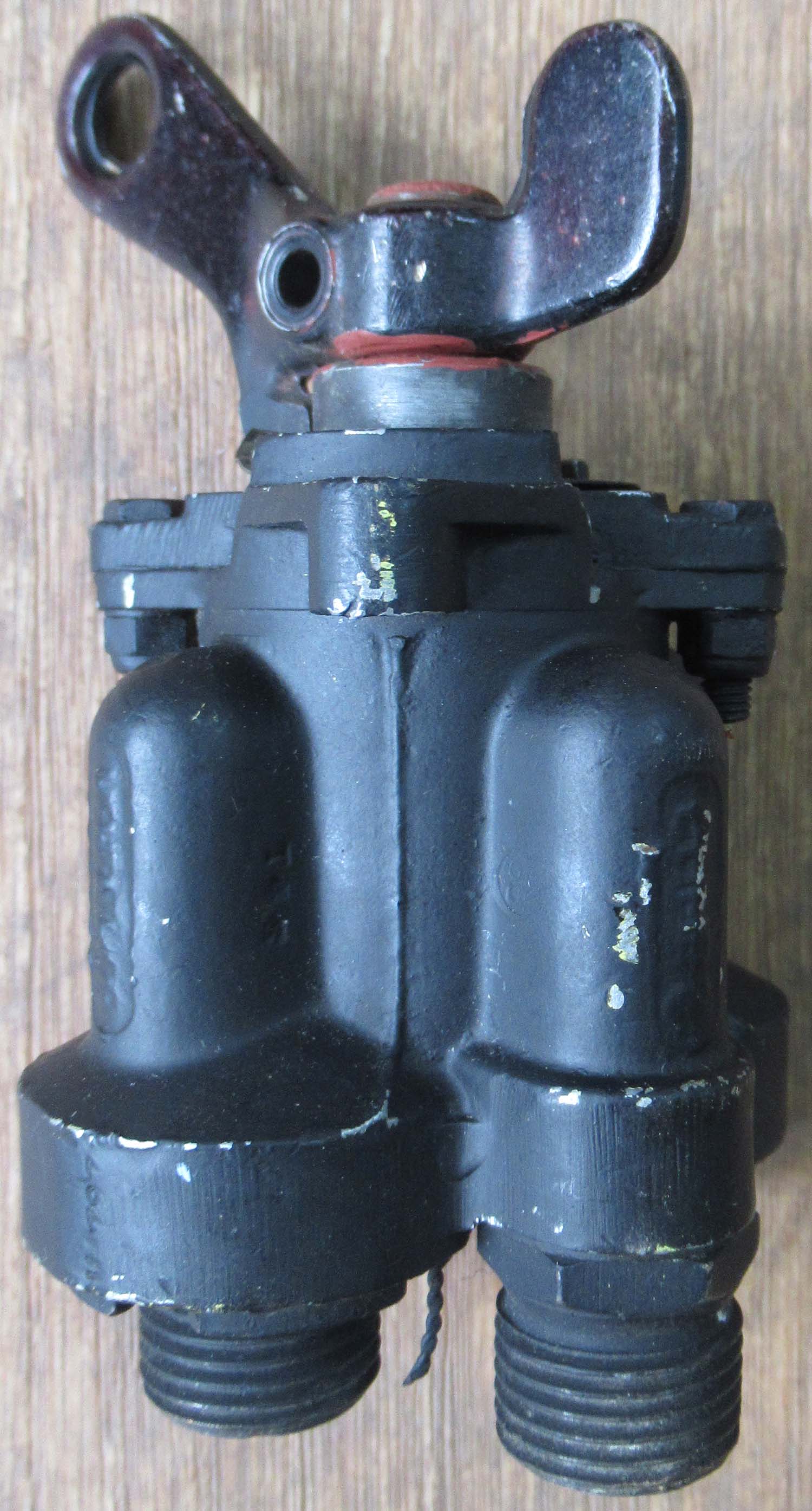
|
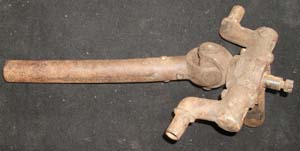
Click on the
pictures to enlarge

Click on
the pictures to enlarge |
Hurricane control Column (pg1 cont)
Here is the lower part of the
Hurricane control column. I believe the Typhoon and Tempest
used the same unit.

|

Click on the pictures to
enlarge them.
 Out of
stock more wanted
contact me
|
Spitfire De icing pump (pg1 controls)
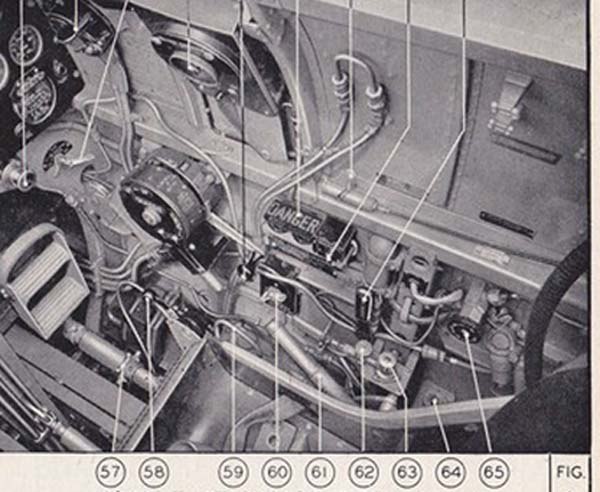
Seen in situ
above Nos 62 and 63 in a Spitfire.
Here is a functioning De icing pump used
in all Mk's of Spitfires and Hurricanes. It is in excellent
condition and still works. In the Spitfire it is mounted on
the RHS of the cockpit next to the Pilots seat. |
|
The levers
move freely and the bores are clean when stripped.

Click on
the pictures to enlarge
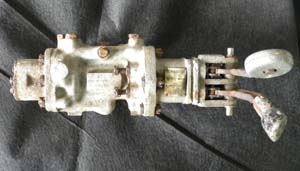
Click on
the pictures to enlarge
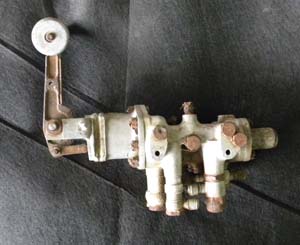
Click on
the pictures to enlarge

|
Mosquito Flap and Hydraulic controls (pg1 cont)

Levers can be
seen in situ in Mosquito cockpit above middle right just
under the turn and slip indicator
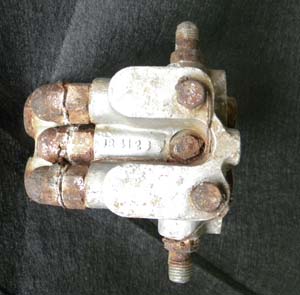
HERE IS AN ORIGINAL DH MOSQUITO
COCKPIT FLAP & UNDERCARRIAGE SELECTOR VALVE AND 1 HYDRAULIC
MODULE
Out of stock
more wanted please
contact us
This item is heavy
please
contact us for postage outside the UK
|
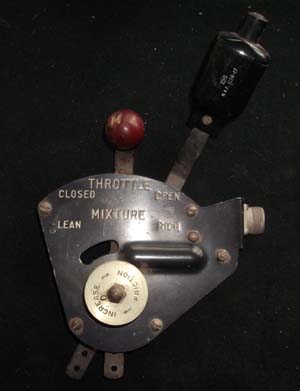
Click on
the pictures to enlarge
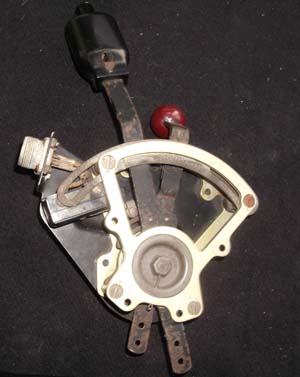 |
USAF Throttle box (pg1 controls)
This is an American wartime
throttle box in superb condition, clearly for a smaller type
of aircraft and similar to the Fairchild and the
P47, so far I have been unable to identify the specific aircraft this
was used used in.
If you can identify its use please
email me.
On the top lever is a push
button switch probably for radio use is has the following
numbers.
This throttle appears to be
orientated for use the the right hand side of the cockpit
and has an electrical connection.
OH
N.A.F-1124-17

Out of stock more always wanted please
contact me
|

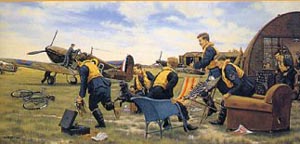
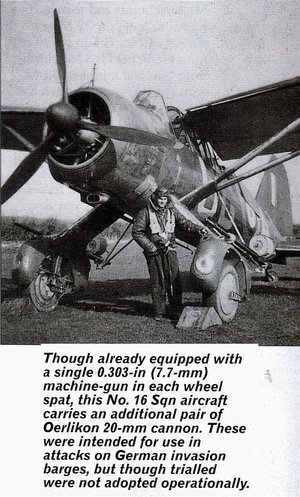 |
Battle of Britain Lysander grip (pg1 cont)
This is a superb possibly unique piece
of Battle of Britain History.

This grip was fitted to the
Westland Lysander an army cooperation aircraft. The Lysander
was fitted as standard with two MGs operated with a single
round firing button on the spade grip. But in 1940 with
invasion looming the RAF suffered from a lack of light
bombers and surface attack aircraft needed to attack the
invasion fleet. With typical Great British ingenuity 20mm
cannons were attached to the Lysander undercarriage. This
being the case the gun button was redesigned in similar
format to the later cannon armed Spitfires with a twin
rocker arrangement. We now know the invasion did not happen
and the Lysander was not a suitable platform for 20mm cannon
and so very few of these were trialled and only fitted for a
very short period in 1940. This being the case this superb
spade grip in A1 condition has to be a must for the serious
battle of Britain and spade grip collector.
This is Missing the Brake Lever but a
Reproduction one can be fitted upon request
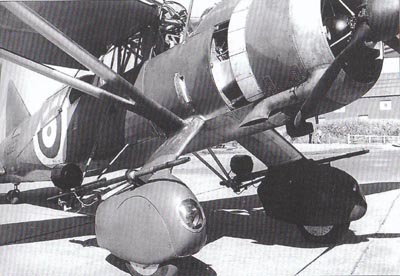
Out of stock
more required please
contact me
|
|
Click on the
pictures to enlarge them.


Out of stock more required please
contact me
|
Complete original Hurricane control Column (pg1 cont)

This a superb complete
Hurricane control column in fully functional condition
although it would need inspection and certification to fly
again. The label on the base says it was taken from
Hurricane Z 5145 FN-D 331 Squadron crashed 27th August
1941 Pilot Jens Muller. I have no way of authenticating this
and do not guarantee this provenance, the information was
attached to the base when I bought the column. Its likely
that only some parts of this column may have been recovered
form from the crash site as this column would not survive in
this condition after a crash. There is some information
about this crash
on
this link
Click on the
pictures to enlarge them.

|
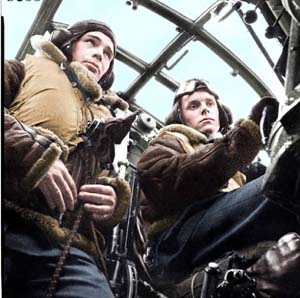
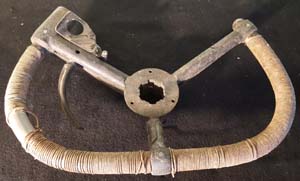
Click on
the pictures to enlarge them

Out of stock more
wanted please
contact me.
|
The rest of the items on this page are currently out of
stock and parts we want to buy please go to page two for
more control parts

Lancaster Control yoke (pg1 cont)
This is an original and incredibly rare
Lancaster control yoke . In nice original condition the park
brake still works and it is complete, accept for the
radio transmit button which can be replaced if required. Not
all Lancasters were fitted with this button as can be seen
from the early Lancaster .
The covering which is
coming away from the grip, appears to be a later addition as
you can see from the grip in situ in an early Lancaster
under the grip had no covering , the Pilot always wore
gloves so there was really no need to cover the yoke.

Click on
the pictures to enlarge them
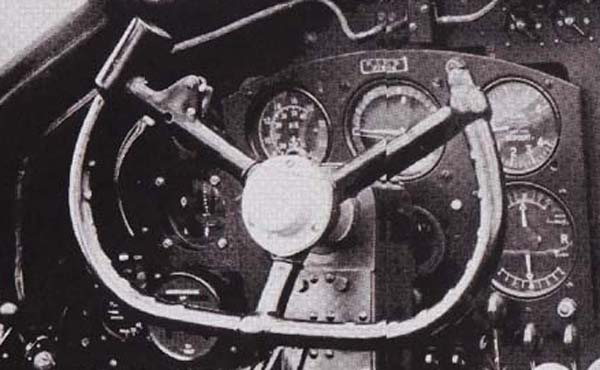
Enlarge the
above picture to see the complete Lancaster Cockpit
|
|
Click on the
picture's to enlarge them.

Out of stock
more required
please contact me |
Hawker Fury Grip and column (pg1 Controls)

Shown above
the Hawker Fury MK II
This is a superb piece an
early 1930s grip with paddle gun firing complete with its
Bowden cables and column in good original condition.
This
grip was fitted to several 1930s RAF front line fighters
including the Fury and Gladiator.
Click on the
picture's to enlarge them.
 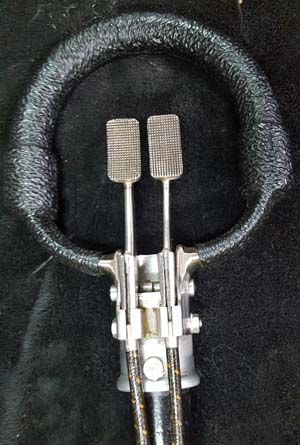 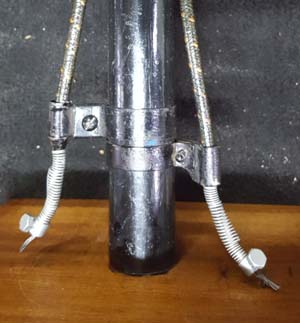 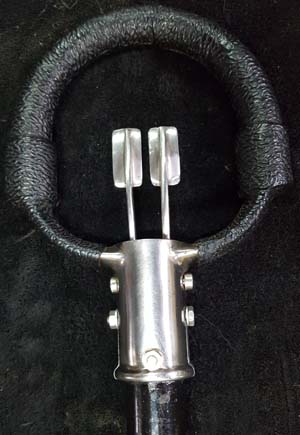
|
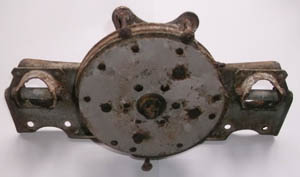
Click on the
pictures to enlarge them


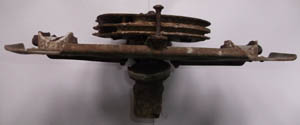
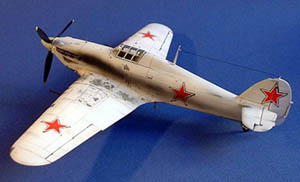
|
Hurricane Aileron Control drum (Pg1 cont)
Click on the
picture to enlarge
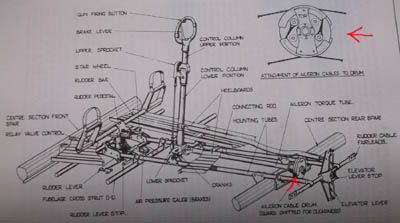
This is an Aileron control
drum which attaches to the control column of the
Hurricane. This piece was imported from the Archangel
district of Russia. It has been lying on the surface of a
Russian forest for 70 years but is in remarkably good
condition. It does have some damage and corrosion as would
be expected but is complete. Some 3000 Hurricanes were sent
to Russia from Britain during WWII and saw some of the most
brutal fighting of the war as the Germans embarked on a war
of annihilation against Russia.

Shown above a Mk IIa Hurricane in
Russian markings equipped with two SkVas 20mm gun and two
UBT 12.7mm machine guns instead of the original .303 calibre
weapons. Some Hurricanes used by the VVS had RS-82 air to
air rockets installed under the wings (three per wing) and
some others sported locally produced bomb racks. Many
Hurricanes were used as tactical reconnaissance aircraft as
this one used by 14th ORAE squadron during winter 1942-1943
near Moscow.
Out of stock more always required please
contact me |
|

Click on the picture's to
enlarge
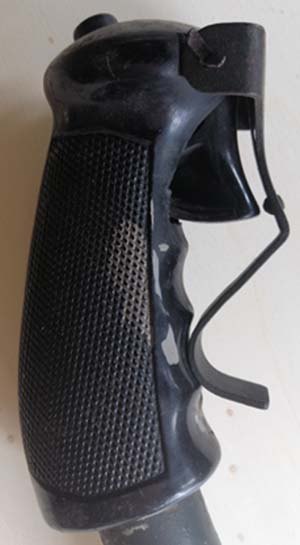
|
P 51 Mustang Grip (pg1 cont)
Here is a
grip as used in the P 51 Mustang in nice original condition.
Unusually it has a safety to protect the trigger.
Due to its
British Merlin engine, laminar wings and a radiator that created
enough thrust to negate the drag of the radiator the P 51
Mustang had a huge range compared to other front line fighters
like the Spitfire.
With drop
tanks it could escort bombers all the way to the targets in
Germany. By the time the Mustang entered escort service the
Luftwaffe was already desperately short of pilots and aircraft
and the arrival of fighters over Germany devastated the
beleaguered German squadrons leading to complete allied air
superiority. The Mustang however was not without its faults
tending to stall without warning. In comparison the Spitfire
being designed as a pure interceptor fighter simply did not have
the range as an escort fighter but was more forgiving aircraft
to fly.
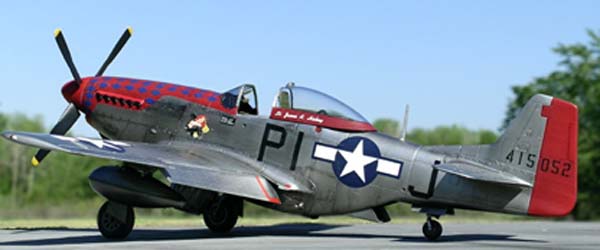
Above the P47
D
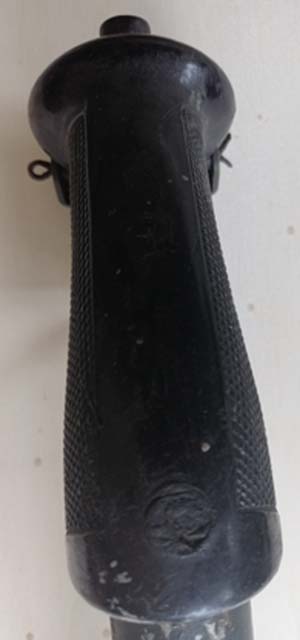

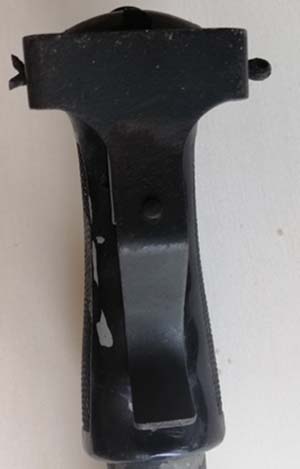
Click on the picture's to
enlarge

Out of stock more
wanted please
contact me. |
|
Click on the
picture to enlarge
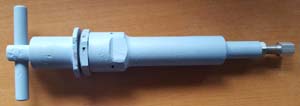

|
Hawker Typhoon Coffman starter control (pg1 cont)
This is a very nice piece
fitted in the Hawker Typhoons cockpit and used to cycle the
cartridges used by the Coffman starter to fire up the
engine. A Coffman starter replaces the electric starter and
was used on of Aero engines , it used an explosive cartridge
similar to a shot gun shell to spin the starter motor which
in turn spun the engine.
Out of stock more
wanted please
contact me. |
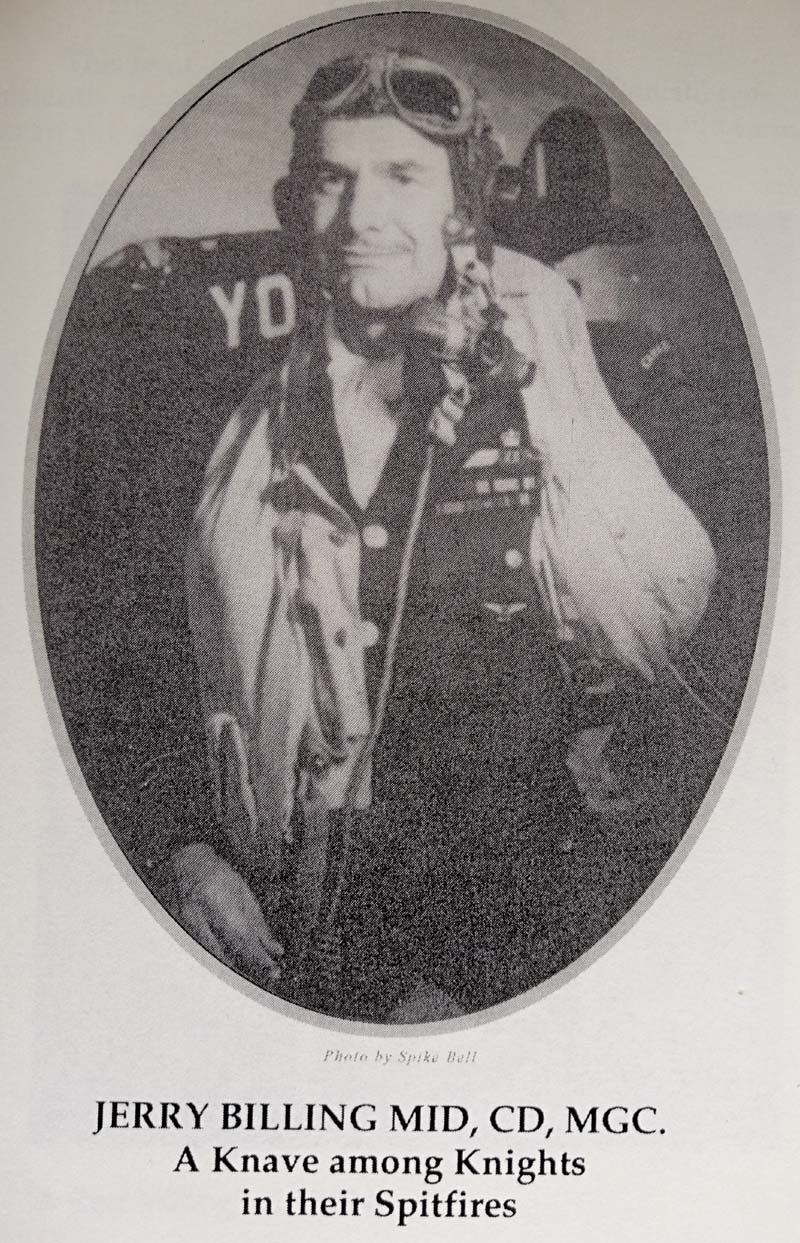
Out of stock
more always wanted please
contact me
|
Hurricane Spade grip (pg1 cont)
Here is an original and complete
Spade grip for the Hurricane.
The AH 2040 Grip's were used in a
number of different aircraft types but this one was owned by
Canadian Fighter Pilot Jerry Billing MID, CD, MGC.
I purchased this from His
Son.
Its unclear whether he actually
flew the Hurricane this stick came from but I was told he
removed it himself as a memento so I think its likely that
he did. Jerry was primarily a Spitfire Pilot and continued
to fly Spitfires until the 90s His last flight being at the
age of 73. His Son told me He holds the record for the most
hours ever flown in a Spitfire.
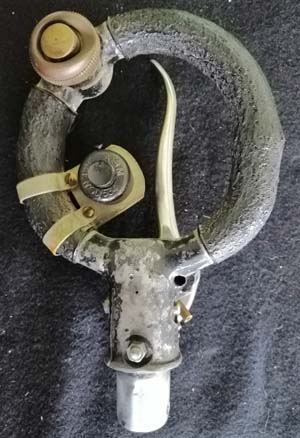
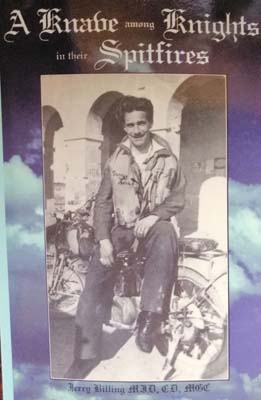
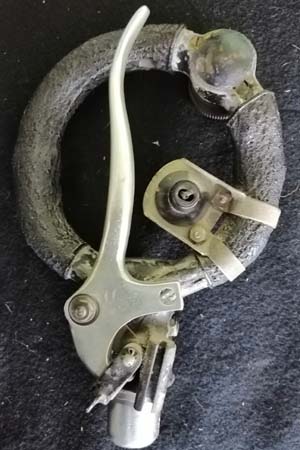
The grip itself is
complete with its original brake lever and parking catch and
unusually has a camera gun button fitted. Its in good
original condition. and other than some paint loss is fully
functional. The grip will come with Jerry's autobiography
which came from His Son with the grip.
Click on
the pictures to enlarge them
|
|
Click on
the pictures to enlarge them
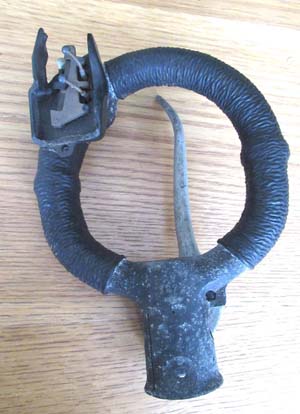
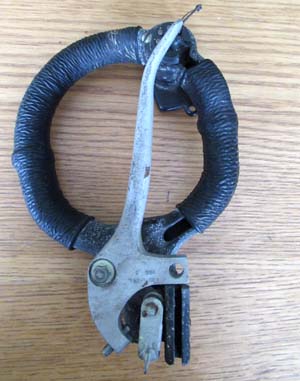 |
Original MK I/II Firefly Spade grip AH 8272 (pg1 cont)
Here is a Spade Grip as fitted
to the MK I and II Firefly the grip is in good condition
with only very light surface corrosion no restoration of any
kind. The grip covering is again in good condition with no
cracking. It is fitted with its original brake lever and
parking brake bracket.
It is fitted with the
Naval Selectric firing button which is unfortunately
broken beyond repair but some of these grips were fitted
with a single firing button and it has the same
pattern to accept a single button.
Shown
below a Fairey Firefly on the deck of a carrier.

Click on
the pictures to enlarge them
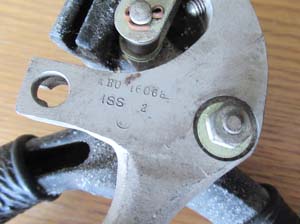 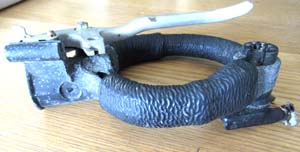 
Out of stock
more required please
contact me |
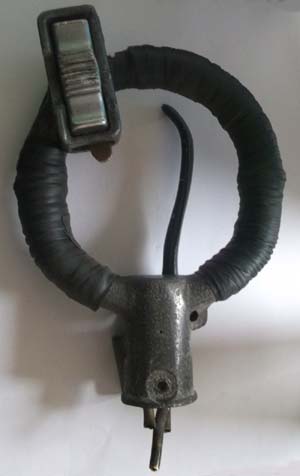
Click on
the pictures to enlarge them

 |
Spitfire Spade grip AH 8068 (pg1 cont)
This is a Spitfire Spade grip ,
it is the earliest production model fitted with the twin
rocker cannon and MG firing button and was fitted to the
Seafire, Spitfire Mks I B, II B, VB, VC, F.VI, VII, VIII,
FIX, FXII, FXXI
The grip has some
restoration with a new covering and a reproduction brake
lever in alloy. It has no filler and only some light
pitting. There is surface rust on the parking brake.
Grip Reference AH 8068
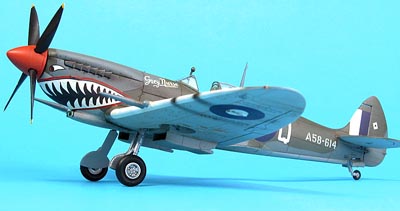
Above the
famous Australian MK VIII Spitfire Grey Goose
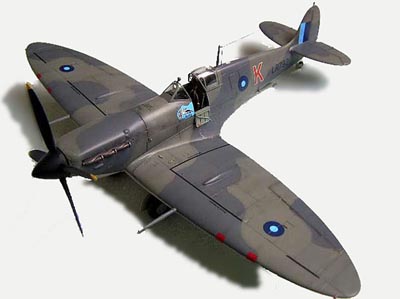
Above Mk II C
Seafire
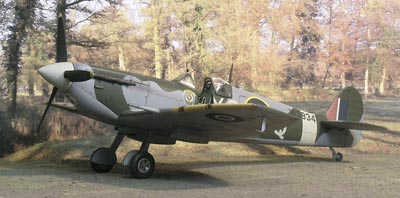
Above Mk VB
Spitfire
Out of Stock
more always wanted please
contact me.
|
|
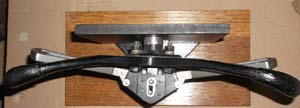
Click on
the pictures to enlarge them


Seen in
situ in a Halifax Cockpit 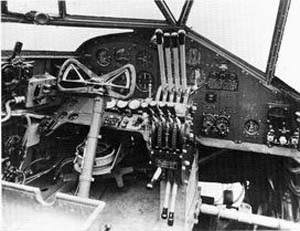
|
Halifax Control
Yoke (pg1 cont)
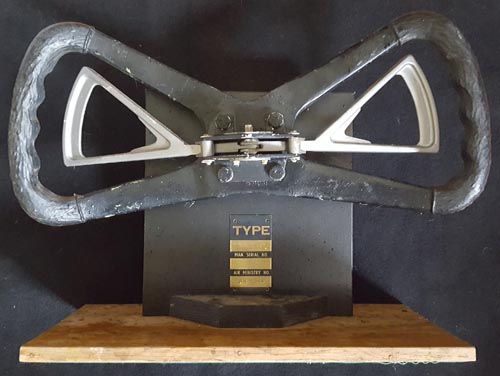
Click on
the pictures to enlarge them
The Handley Page Halifax
was first flown on 25 October 1939 from RAF Bicester and
entered service with 35 Squadron in November 1940. The first
Halifax raid by the squadron was against le Havre, France,
on 10 March 1941.
The Halifax I and II
aircraft were powered by Rolls-Royce Merlin engines and the
Halifax III was powered by Bristol Hercules engines.

Apart
from the role as a heavy bomber, the Halifax III and later
versions also served in Coastal Command and in Para trooping
and glider towing roles with the Airborne Forces. Halifax
production totalled 6,178, the bomber versions flying a
total of 75,532 sorties in the Second World War.
This Control Yoke is in
good original Condition with the brake levers moving freely.
It is
displayed on a wooden Display base with a plaque stating the
Type of Aircraft and Air Ministry Number
Out of stock
more required please
contact me
|
|
Click on the
Pictures to enlarge them

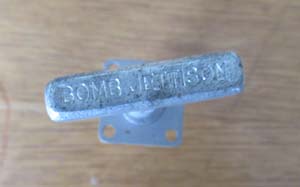
|
Lancaster Bomb Jettison Control (pg1 Controls)
Totally original and super
rare fitted to the Lancaster main instrument panel used for
jettisoning the bombs in an emergency in very good original
condition and complete.

Seen above in
situ in a Lancaster. Click on the
Pictures to enlarge them
Out of stock more
wanted please
contact me.
|
|
Click on the
Pictures to enlarge them
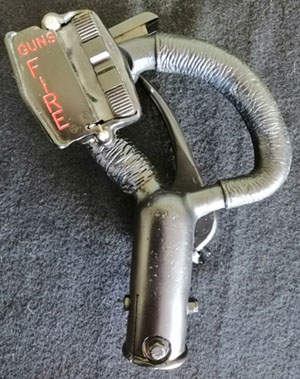
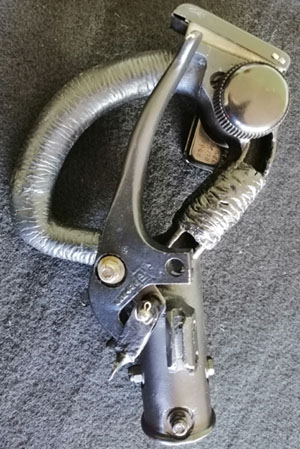
|
MK F 24 Spitfire Spade Grip (Pg 1 Cont)
This is a Spade grip for the
late model Spitfire , its is completely original and in very
good condition, it is complete with its firing button brake
lever and parking brake.
Part number
AH 8400. Seen under the MK 24 Spitfire
 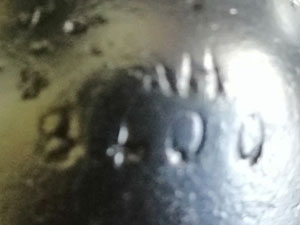 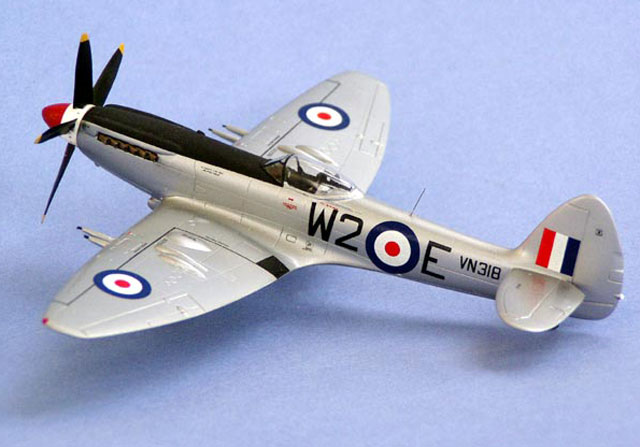
The F22/24 Spitfire had little in common with
these early Spitfires other than the name.
A 2,050 hp Griffon 61 engine was housed in a
bulged forward fuselage driving a big five bladed (or even
six bladed counter-rotating) propeller.
The rear fuselage was cut down with a
clear-vision bubble canopy over the cockpit.
The wing was a totally new design, as were
the tall tail surfaces and revised horizontal stabilisers.
Most of the structural changes were necessary to restore the
Spitfire's excellent handling that was being progressively
eroded by its increased weight, length and power.
Main armament was four Hispano 20mm cannon. This late
Spitfire could also carry under-wing stores consisting of
either eight rockets or up to 1000 lb. of bombs. Top speed
was 454 mph.
The F22/24 looked very much like a Spitfire on steroids. It
was one third faster than its earliest ancestor, possessed
twice the rate of climb and its fully laden weight was
almost double the empty weight of a Mk. I!
Only 81 Spitfire F24s were delivered in the dawning
jet-age.
Out of stock more
wanted please
contact me. |
 Click on
the pictures to enlarge them

Click on
the pictures to enlarge them
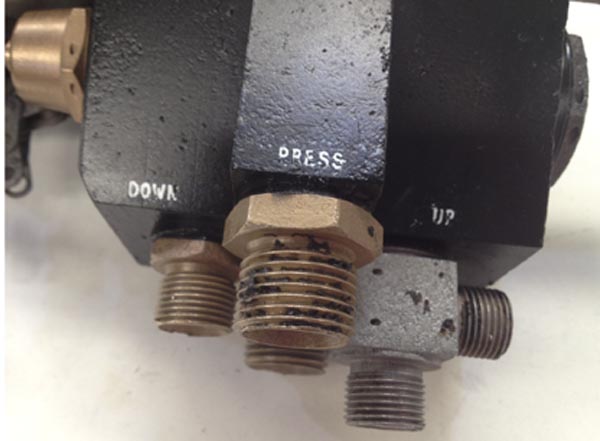
Click on
the pictures to enlarge them
|
Original Spitfire undercarriage selector * (pg1 cont)
He is a really rare
original Spitfire undercarriage selector , it is complete
although part of the cover is missing. It currently does not
function and the lever is seized.
Click on
the pictures to enlarge.
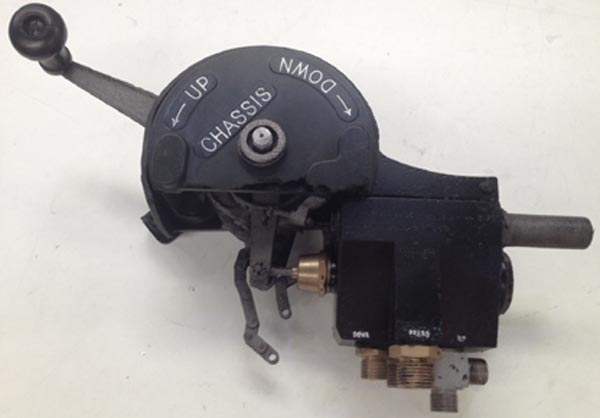
Out of Stock More Wanted
Contact Us |
|
Click on
the pictures to enlarge them
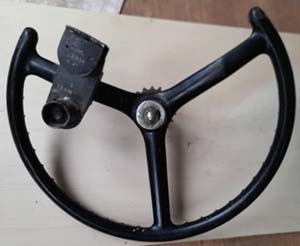
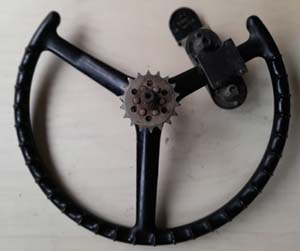


Out of Stock
more always wanted please
contact me.
|
Short Sunderland control Yoke and column (pg1 cont)
This is a superb peace.
This Control Yoke and column from a Short Sunderland flying
boat comes complete with its matching control column.
This is the first one in
over 20 years I have seen let alone owned its incredibly
rare and this one is in superb condition. It has been in the
ownership of the previous owner for over 60 years. It was
removed from one of two flying boats either ML 820 or ML
821.
The
evolution of the flying boat proceeded rapidly in the 1920s
and 1930s.
Development of the type reached a peak during World War II,
when large flying boats were fielded by most of the major
combatants in substantial numbers.
One of the most prominent of these aircraft was the British
"Short Sunderland", an excellent machine that made a major
contribution to the Allied war effort, particularly in the
Battle of the Atlantic against German submarines or
"U-boats".
Click on
the pictures to enlarge them
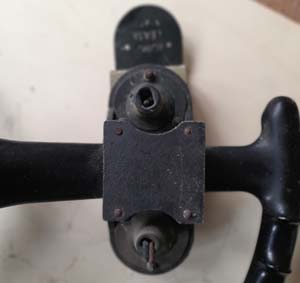 
The RAF received its first Sunderland Mark I
in June 1938, when the second production aircraft was flown
to Singapore. By the outbreak of war in Europe in September
1939, RAF Coastal Command was operating 40 Sunderlands.
Sunderlands quickly proved useful in
the rescue of crews of torpedoed ships. On 21 September
1939, two Sunderlands rescued the entire 34 man crew of the
torpedoed merchantman KENSINGTON COURT from the North Sea.
As British anti-submarine measures improved, A Royal
Australian Air Force (RAAF) Sunderland performed the type's
first unassisted kill of a U-boat on 17 July 1940.
It was a well-built machine that was hard to
destroy. On 3 April 1940, a Sunderland operating off Norway
was attacked by six German Junkers Ju 88 fighters, and
managed to shoot one down, damage another enough to send it
off to a forced landing, and drive off the rest. The Germans
were supposed to have nicknamed the Sunderland the "Fliegende
Stachelsweine (Flying Porcupine)".
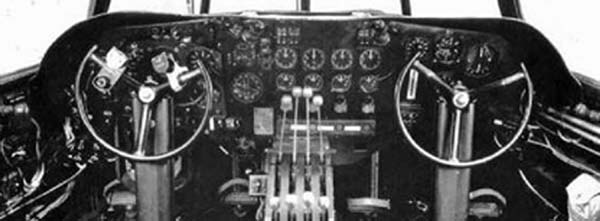 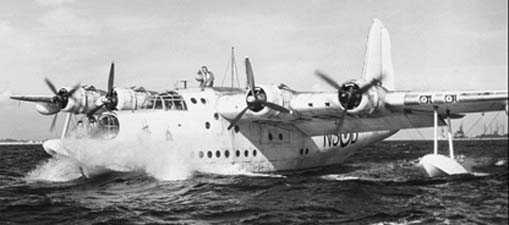
Above the
Cockpit of a Short Sunderland flying Boat.
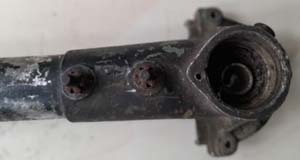 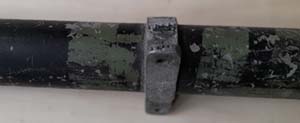 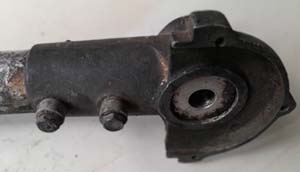
|
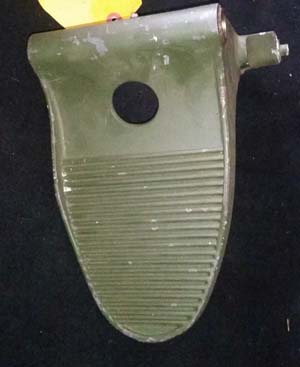
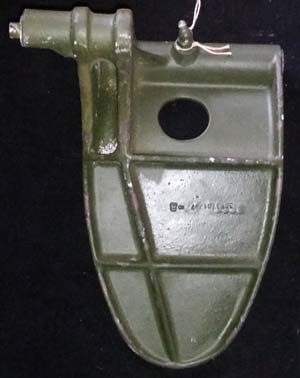
Click on the
pictures to enlarge them
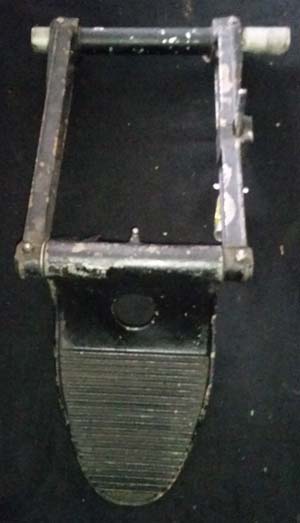

|
P-47 Thunderbolt
Rudder Pedals (pg1 cont)
Here is a pair Rudder Pedals as
used in the Republic P-47 Thunderbolt. The Pedals have Part
Number 30F37017
The Frame on the Left Pedal
has Part Number 30F37101-3-A1535

Republic P-47
Thunderbolt
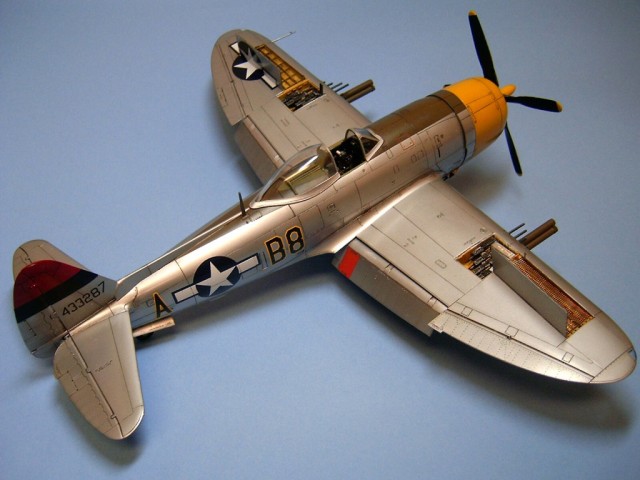
The P-47
Thunderbolt, or 'The Jug' as it came to be known, was a
design of Georgian immigrant Alexander Kartveli, and was to
replace the Seversky P-35 that was developed earlier by
Russian immigrant Alexander P. de Seversky
It was
one of the main United States Army Air Forces (USAAF)
fighters of World War II, and served with other Allied air
forces, notably those of France, Britain, and Russia.
The
first P-47 combat mission took place 10 March 1943 when the
4th FG took their aircraft on a fighter sweep over France.
The mission was a failure due to radio malfunctions. All
P-47s were refitted with British radios, and missions
resumed 8 April. The first P-47 air combat took place 15
April with Major Don Blakeslee of the 4th FG scoring the
Thunderbolt's first air victory against a Fw 190.
On 17
August, P-47s performed their first large-scale escort
missions, providing B-17 bombers with both penetration and
withdrawal support of the Schweinfurt-Regensburg mission,
and claiming 19 kills against three losses.
Although
the North American P-51 Mustang replaced the P-47 in the
long-range escort role in Europe, the Thunderbolt still
ended the war with 3,752 air-to-air kills claimed in over
746,000 sorties of all types, at the cost of 3,499 P-47s to
all causes in combat
Serviceability
Ticket For Right Rudder Pedal

In Europe during the critical first three months of 1944
when the German aircraft industry and Berlin were heavily
attacked, the P-47 shot down more German fighters than the
P-51 (570 out of 873), and shot down approximately 900 of
the 1,983 claimed during the first six months of 1944. In
Europe, Thunderbolts flew 423,435 sorties which is more than
P-51s, P-38s and P-40s combined. Indeed, it was the P-47
which broke the back of the Luftwaffe on the Western Front in the critical period
of January–May 1944
By the
end of the war, the 56th FG was the only 8th Air Force unit
still flying the P-47, by preference, instead of the P-51.
The unit claimed 677.5 air victories and 311 ground kills,
at the cost of 128 aircraft. Lieutenant Colonel Francis S.
Gabreski scored 31 victories, including three ground kills,
Captain Robert S. Johnson scored 27 (with one unconfirmed
probable kill leading to some giving his tally as 28),and
56th FG Commanding Officer Colonel Hubert Zemke scored 17.75
kills. Despite being the sole remaining P-47 group in the
8th Air Force, the 56th FG remained its top-scoring group in
aerial victories throughout the war.
P-47 Pilot
Francis Gabreski - 8th Airforce Leading Fighter Ace
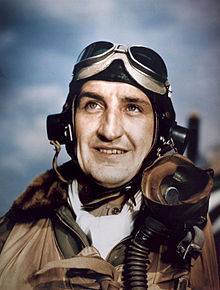
Out of
stock more wanted
contact me
|
|
Click on the
pictures to enlarge

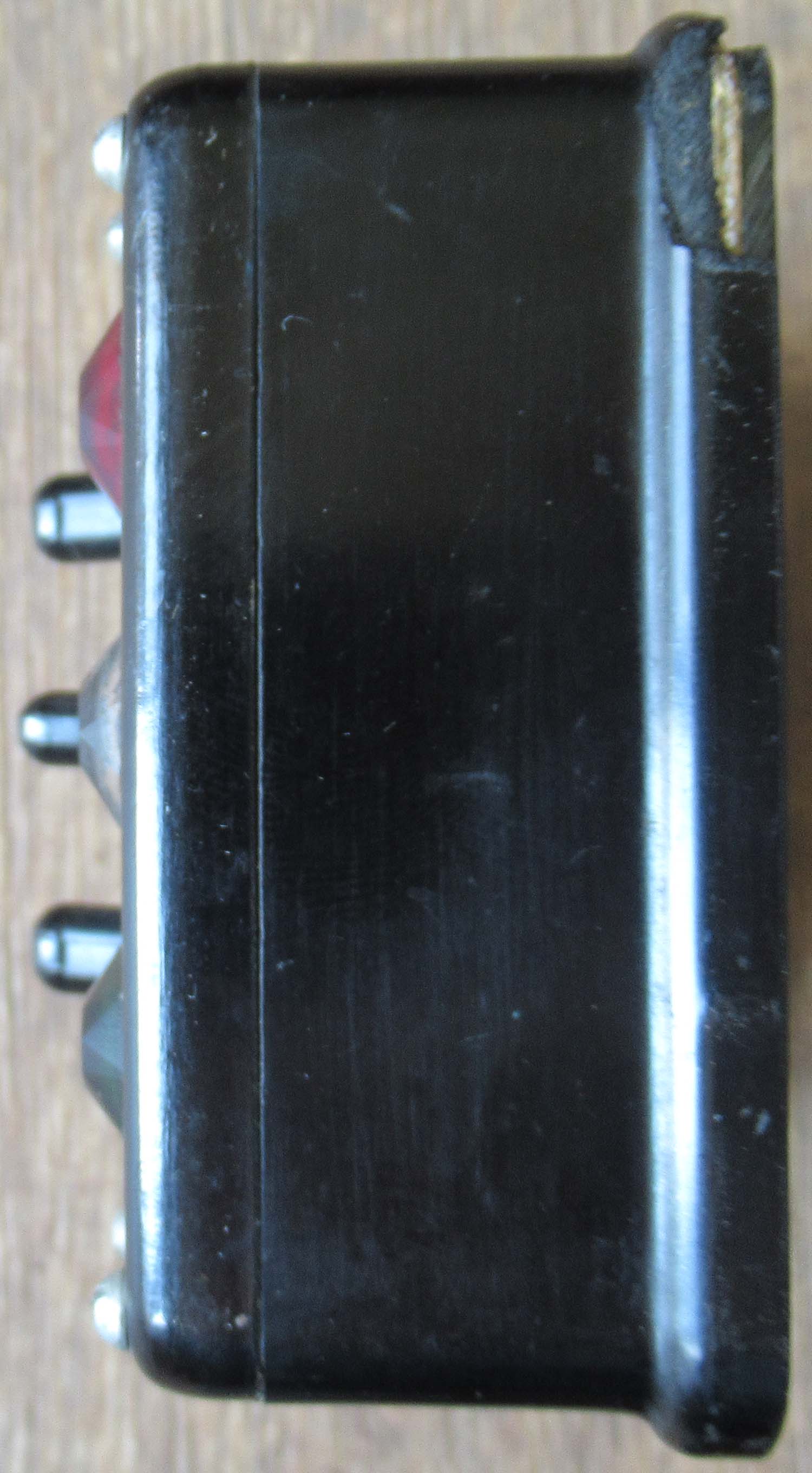
Out of stock
|
Flying boat Taxi
control (Pg1 Cont Nos 53 )

This is a really attractive
rare and interesting peace.
This box was fitted to flying
boats the ground crew would guide the
Flying boat to its mooring using a switch connected I'm
guessing to a transmitter and receiver to signal the pilot
to turn to port by illuminating the red light, white for
straight ahead and green to turn starboard.
5C/778
Click on the
pictures to enlarge

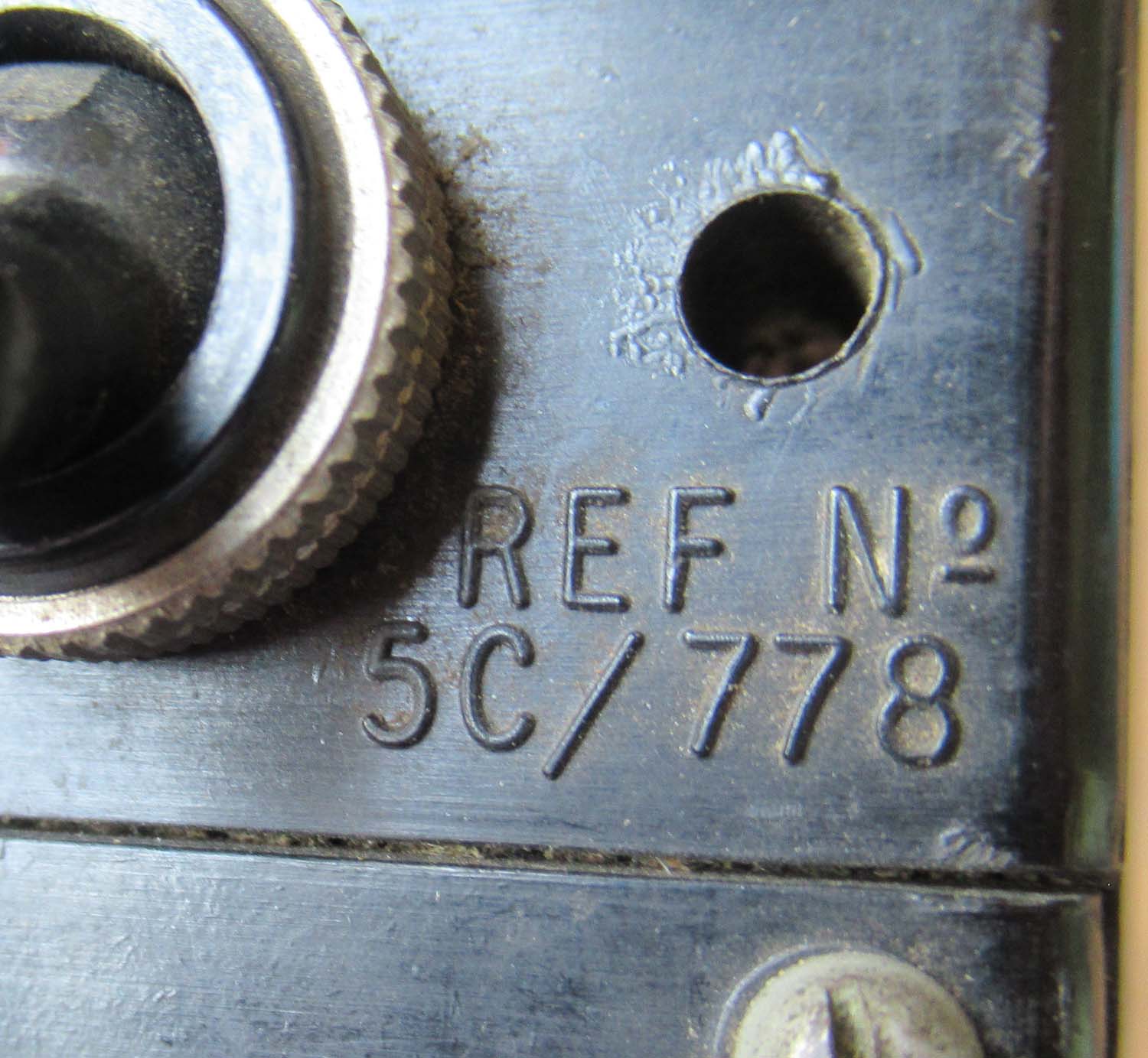
Some of the corners are
slightly chipped the switches and button work as they
should.
A beautifully simple and
elegant peace and a great thing for the collector of flying
boat memorabilia.
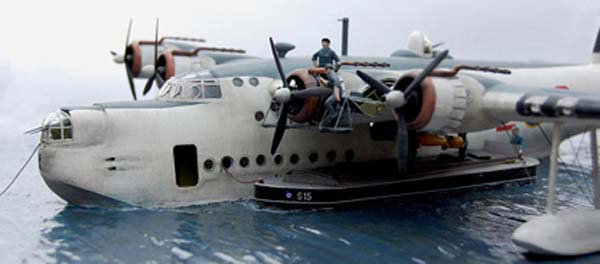

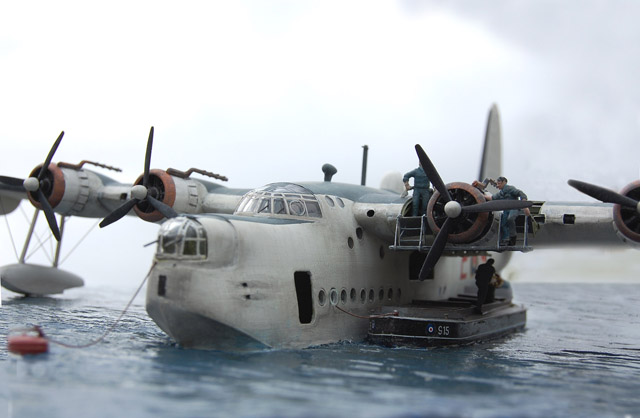
Above the
Short Sunderland Flying Boat
The RAF received its first Sunderland Mark I
in June 1938, when the second production aircraft was flown
to Singapore. By the outbreak of war in Europe in September
1939, RAF Coastal Command was operating 40 Sunderlands.
Sunderlands quickly proved useful in the
rescue of crews of torpedoed ships. On 21 September 1939,
two Sunderlands rescued the entire 34-man crew of the
torpedoed merchantman KENSINGTON COURT from the North Sea.
As British anti-submarine measures improved,
the Sunderland began to show its claws as well. A Royal
Australian Air Force (RAAF) Sunderland performed the type's
first unassisted kill of a U-boat on 17 July 1940.
As the British honed their combat skills, the
Sunderland Mark I received various improvements to make it
more effective.
The nose turret was upgraded to two
7.7-millimeter guns instead of one. New propellers, and
pneumatic rubber wing de-icing boots, were fitted as well.
Although the 7.7-millimeter guns lacked range
and hitting power and the British would in time understand
the need for more formidable weapons, it was a well-built
machine that was hard to destroy.
On 3 April 1940, a Sunderland operating off
Norway was attacked by six German Junkers Ju 88 fighters,
and managed to shoot one down, damage another and
drive off the rest. The Germans nicknamed the Sunderland the
(Flying Porcupine)".
|
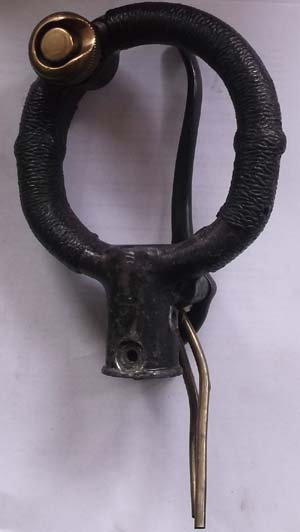
Click on
the pictures to enlarge them
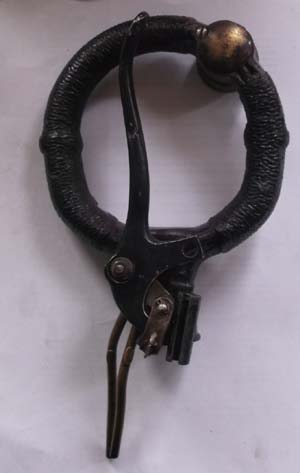
 |
Hawker Hurricane Control grip (pg1 cont)
This is an original Hawker
spade grip complete with its original brake lever and
parking brake all in excellent original condition.
Everything functions as it should do the firing button
depresses turns and locks.

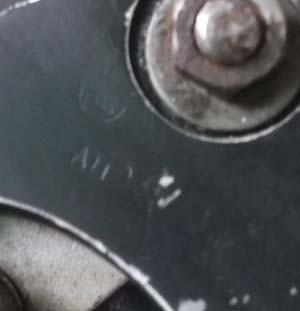
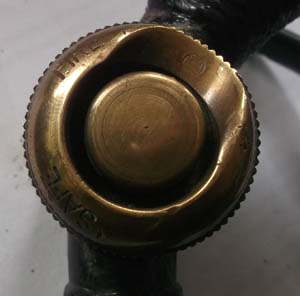
AH 2040
|
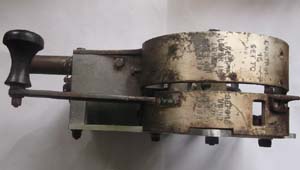
Click on
the pictures to enlarge them
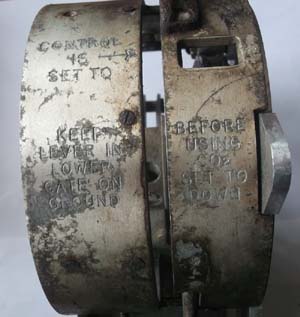
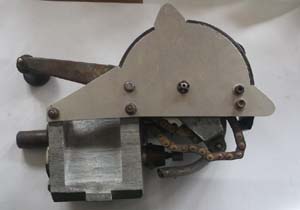
Click on
the pictures to enlarge them
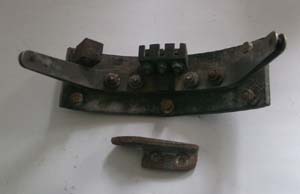
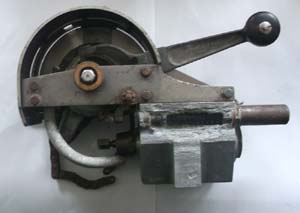
|
Spitfire undercarriage selector (pg1 cont)
This is a very rare Spitfire
undercarriage selector used for lowering and raising the
undercarriage. All the gearing works and
the lever moves freely, the valve block is corroded see
pictures but the valve in the block does move in and out so
the internals appear to be OK and other than the corrosion
on the side the block appears in excellent condition.. This piece is extremely
rare and the first I have had for sale.
Click on
the pictures to enlarge them

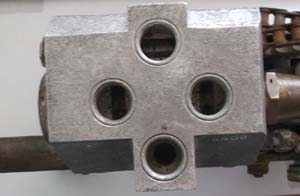
Seen in situ
in a Spitfire under.
Wanted if you
have one available in any condition please
contact me
|
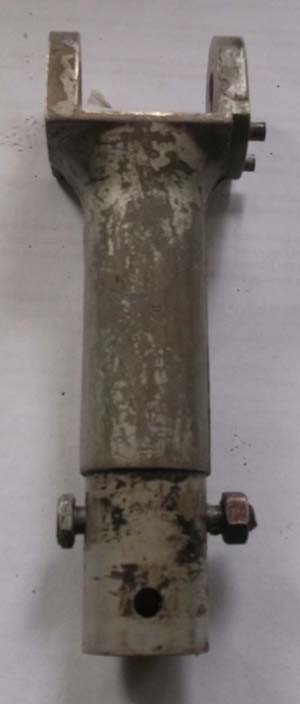
 |
Hurricane control column top (pg1 cont)
This is an original
Hurricane column top in excellent condition and
corrosion free.
Click on
the pictures to enlarge them
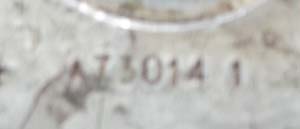
Seen in situ in a Hurricane
cockpit under
Out of stock
more always wanted
contact me |
|
Click on
the pictures to enlarge them
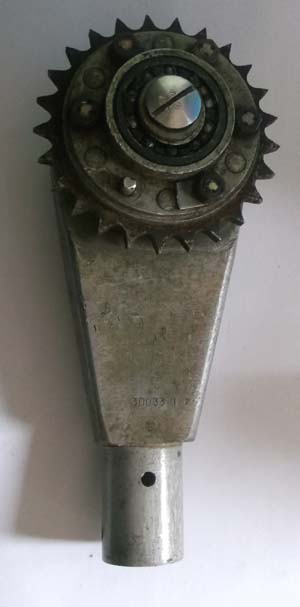
|
Spitfire control column top (pg1 cont)
This is a Spitfire Spade control
column top complete with sprocket in excellent condition and
corrosion free.
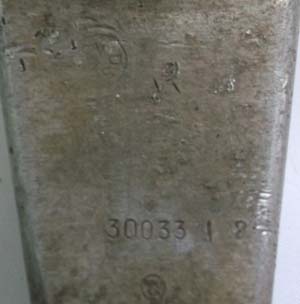

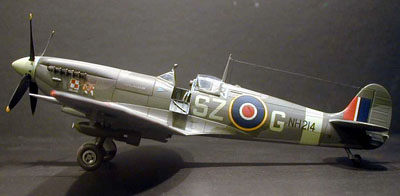

Out of stock
more wanted
contact me
|
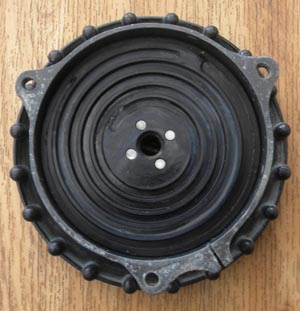
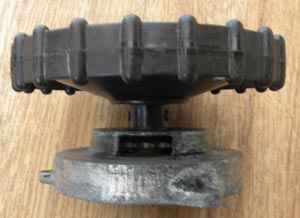
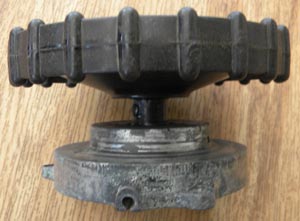
Out of stock more always wanted
contact me
|
Original Spitfire trim unit (pg1cont)
This is a superb original
Spitfire elevator trim unit, in good original condition.
From looking at the drawing it appears to be complete apart
from the back plate and cable. This like all original
Spitfire parts is extremely rare and the first to appear on
this site.
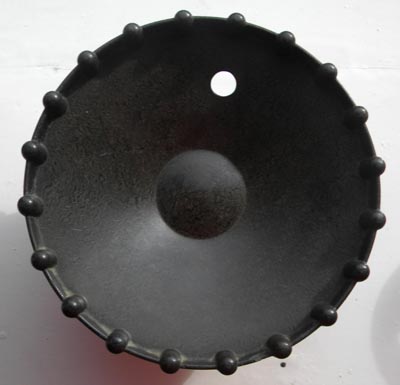
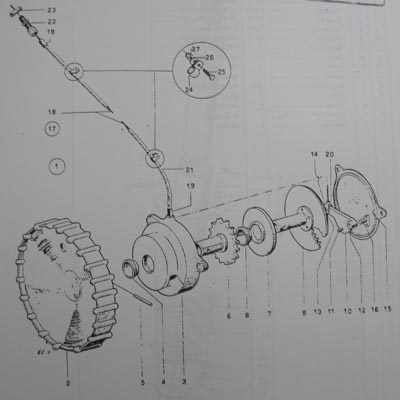
|

Click on the
pictures to enlarge them

Complete serviceable
units available in
Pilot Equipment link here
|
Spitfire Harness release (pg2 cont)
This is a
genuine Spitfire harness release, it is a common design used
on several types of aircraft for releasing the seat harness
in an emergency but this one actually carries the Spitfire
part number. Mounted on the RHS of the pilots seat.
Part number
300 35

Seen in
situ in a Spitfire above centre.
Out of stock
more wanted
email me
|
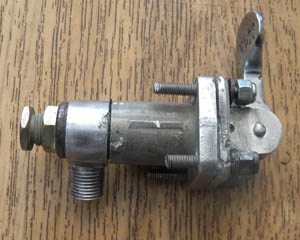

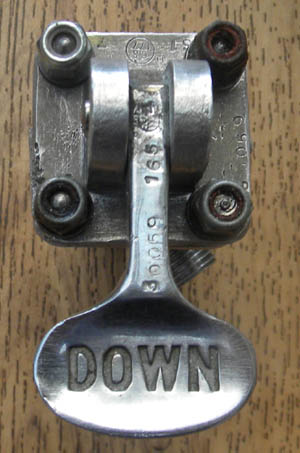
|
Original
Spitfire flap lever (pg2 cont)
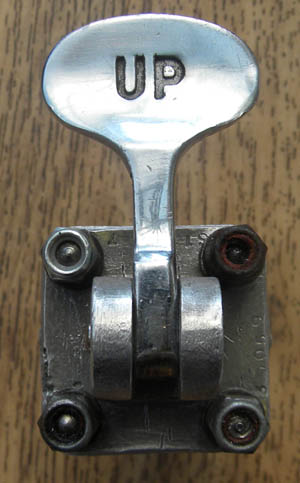

This is superb original
Spitfire flap lever. The valve operates. This is possibly
the rarest item on the Spitfire instrument panel.
N/A
|

Click on the
pictures to enlarge them.

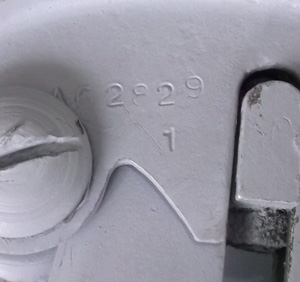 |
Hawker Typhoon seat frame (pg2 controls)
This is a seat frame and
seat adjustment from a Hawker Typhoon in great condition the
button does depress and it functions well.
I believe these are
pretty much the same as the Hurricane seat frame and may
work for both aircraft.

Click on
the pictures to enlarge them.
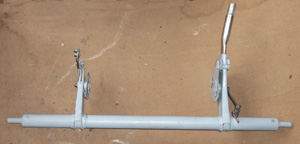
Out of Stock More
Wanted
Contact Us
|


Click on
the pictures to enlarge them

|
Avro Anson Control Yoke (pg1 cont)
Here is a control yoke and
sprocket from an Avro Anson.
The Avro Anson earned its
nickname of "Faithful Annie" by serving the RAF from 1934 to
1968. The Anson Mk.I was a low-wing monoplane with
retractable landing gear, a first for the RAF The
construction, was conventional: the wing was made of spruce
and Bakelite-bonded plywood, and its fuselage of steel tube
with fabric and plywood covering. Originally the Anson's
were painted with a shiny aluminium dope, but after the
outbreak of war camouflage paint was applied. The cockpit
with its large windows gave a good view all around. The
engines were Armstrong Siddeley Cheetah IX radials, with
two-bladed metal propellers. The Anson had a crew of four:
pilot, bomb aimer, gunner, wireless operator. The General
Reconnaissance version had a manually-operated gun turret
with a single .303 gun, and a fixed gun in the nose. The air
gunners were volunteers drawn from the ground crew, who
received an additional shilling a day to their pay. Two
100lb bombs could be stowed internally, and external racks
could carry eight 20lb bombs, flares or smoke generators.
Out of Stock More
Wanted
Contact Us
|

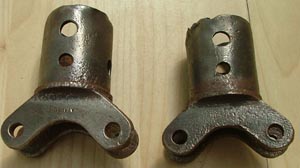
Out of Stock More Wanted
Contact Us
|
Original Hurricane Rudder pedals (pg2 cont)
Once again a superb and extremely rare original set of
Hurricane rudder pedals in restored A1 condition. also included
original stalk fixings.
Click on the
picture top left to enlarge
Seen under in situ in a
Hurricane under.
|

Click on
the pictures to enlarge them

AH 2040
Out of stock
more always wanted
contact me
|
Mk I Hurricane spade grip (pg1 cont)

This is a mint condition
early MK I Hurricane spade grip. This grip was the
forerunner of the WWII Spade grips using push button
firing as apposed to the paddle type levers used on the
earlier 1930s Bi Planes. Practically all grips used in RAF
Wartime fighters were based on this design in one form or
another through the War. This particular grip has the Dunlop
"Patent applied for" legend stamped on it and is extremely
rare. This grip was only used on the MK I Hurricane and was
made of aluminium alloy as apposed to magnesium used in the
later grips reducing their weight. This grip is as good as
it gets complete with an original brake lever and parking
break catch. The parking brake catch is the only piece with
any corrosion being made of steel, this is inevitable on
something which dates from the late 1930's. The covering
which is often in poor shape is original and in as new
condition on this grip. I see no reason why this grip
should not fly again subject to the required checks.

|

Click on the
Pictures to enlarge them
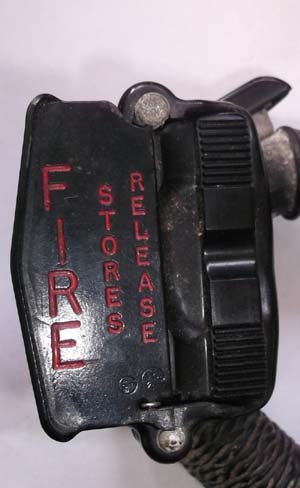
Click on the
Pictures to enlarge them
 |
F 24 Spitfire Spade grip (pg1 cont)
This is a Dunlop Mk II control
grip. It was the first major development in the design of
spade grips for many years and intended as an interim
measure until the introduction of the upright or stick grip
necessitated by the introduction of ejection seats. This
grip was used in a wide variety of aircraft from the last
and fastest of the late piston engine fighters to the new
breed of jets.
Aircraft
that used this grip were the
Hawker fury, Spiteful,
Vampire, Meteor IV, Balliol T 1, Spitfire F 22, F 24.
Spiteful

The Spiteful was a powerful,
well-armed and extremely fast piston-engine fighter that
appeared just too late to serve during World War II. Test
pilots generally found it good to fly, but never in the same
league as the sweet handling of the Spitfire. Its square
laminar-flow wing was optimised for high-speed flight but
also led to the type’s major snag: vicious low-speed
handling, with a nasty stall. This was partly improved by
various airframe changes, but these degraded the upper end
of the flight envelope such that the production aircraft was
little faster than the preceding Spitfire F.22/24.
Spitfire F 24

Nevertheless,
in 1947 the Spiteful F.16 with a
Griffon 101 reached 494 miles per hour (795 kph), a record
that still stands for piston-engine aircraft in Britain.
The end of World War II , coupled with the obvious potential
of jet aircraft, killed off any hopes of the Spiteful being
built in large numbers, with the original RAF Order of 650
aircraft being reduced to just 22, some of which were sent
straight to the scrap yard. The same fate ultimately befell
many of the naval Seafang derivative, which may have had a
fighting chance of serving operationally with the Royal Navy
if it weren’t for Hawker’s superlative Sea Fury.
Sea Fury

Meteor MK IV
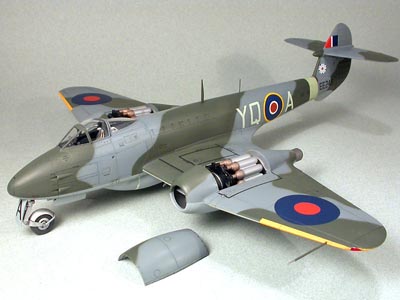
Out of stock more wanted
contact me
|
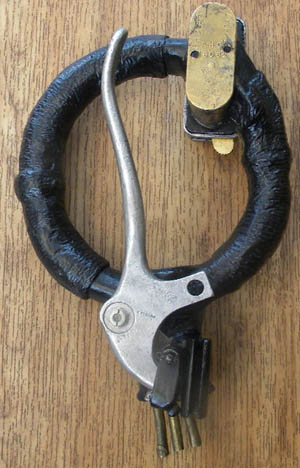

Currently out of stock we
are always looking to purchase Grips
contact me. |
Original Spitfire Spade grip(pg1 cont)
Here is the ultimate Spade
Grip for the Spitfire collector. A very rare item with the
twin cannon and MG rocking gun button. This grip is totally
original including the brake lever. The gun button functions
perfectly. the safe works and the rockers move as they
should. The grip itself is in superb condition the
covering being AI with no cracking.
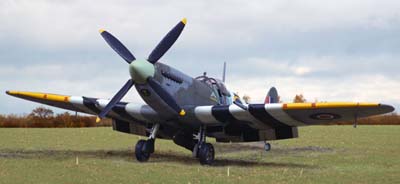
This grip was fitted
specifically to all Spitfires that were armed with 20mm
cannon, so basically from MK V right onwards.



Dunlop Reference
AH 8068
|
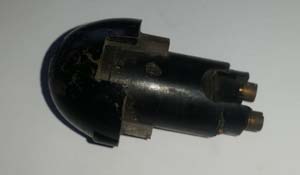
Click on the
pictures to enlarge
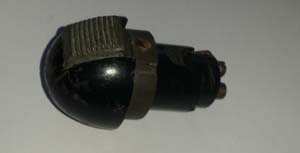
Click on the
pictures to enlarge

Click on the
pictures to enlarge
|
Canadian
Mosquito Dunlop Gun Button (pg1 Arm)
Here we have a Electric Gun
Button Manufactured by Dunlop Canada
This Carries the Dunlop
Part Number AHO16610
This was Used in Canadian
Built DeHavilland Mosquito
There is some Damage to
the Bottom of the Button which can be seen in the photos but
would not be visible when mounted on a Grip
Seen in
situ in the DH Mosquito Cockpit
|
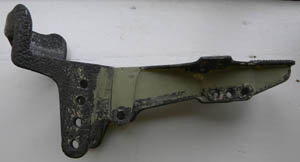 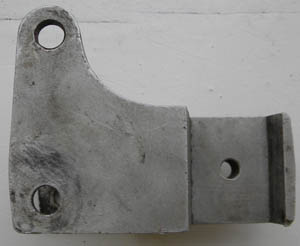
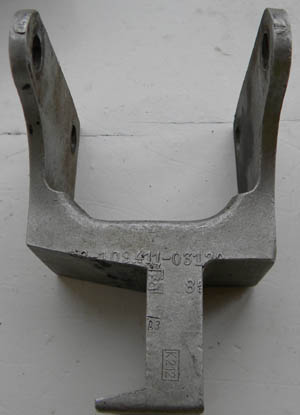 |
FW 190 BF 109 Rudder pedal (pg3 cont)
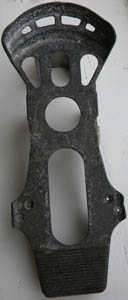
This is an original rudder
pedal in good condition used in a variety of late war Luftwaffe
fighters. This pedal was only fitted to Fighters most notably
the FW 190 and late model BF 109's. It also includes its
mounting block.
Focke Wulf 190
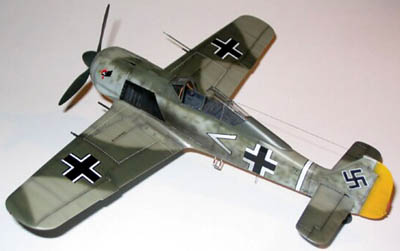
Out
of stock more wanted contact me
|
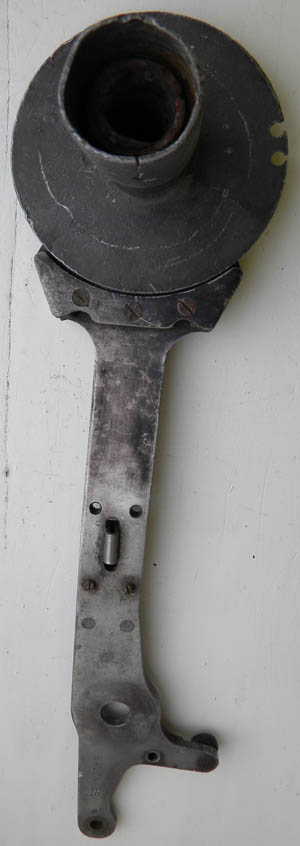
Out of Stock More
Wanted
Contact Us
|
Hawker Tempest throttle part (pg 3 cont )

You can see the attachment for
the cable ends on the grip. left.
This is part of the throttle
from a Hawker Tempest which converts to the Mk II Ace maker giro
Gunsight, the gunsight range control was controlled by twisting
the throttle which a cable attachment to the Gunsight.
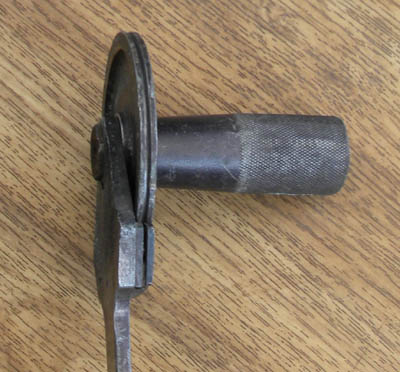
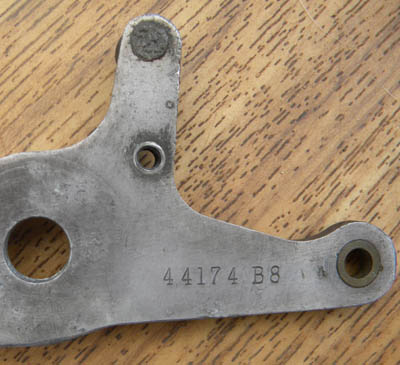
|
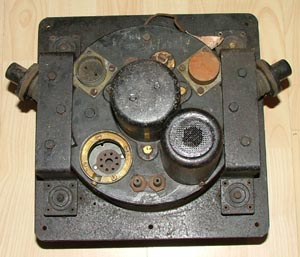 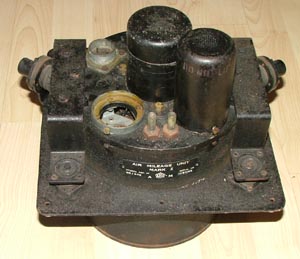 |
Lancaster Air Mileage unit (pg4 cont)

A/M 6B/249
Used by the
navigation in conjunction with the true coarse indicator in the
Lancaster.
Out of stock more
required
contact me
|
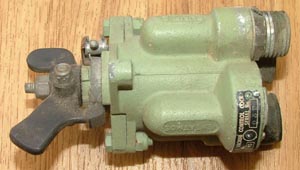

|
Lancaster suction cock (pg4 cont)
A vacuum pump is fitted each
inboard engine on the Lancaster, one operates the six vital
instruments on the blind flying panel, the other operates the
Mk14 bomb sight.
In the event of failure of the pump supplying the blind flying
panel the changeover cock can be operated and the supply is
robbed from the bomb sight and diverted to the vital flying
instruments. It is not possible to operate instruments and
bomb sight from one vacuum pump. The portion seen on the panel
is normally painted red.
Seen in situ in a
Lancaster under
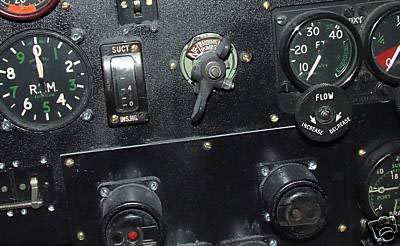
Out of stock more
required
contact me
|
|
|

 |
